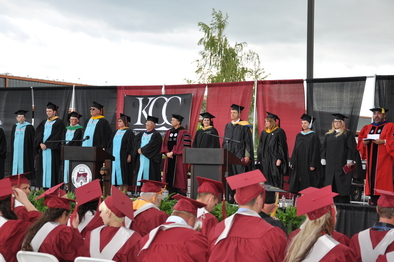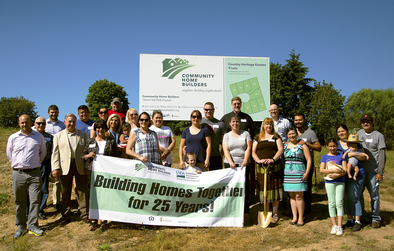|
Welcome to the quarterly newsletter of USDA Rural Development in Oregon. Here, you will find updates on funding opportunities and program activities through our Business, Cooperative, Community Facility, Multi-Family Housing and Single Family Housing programs.
Additional
rural Oregon communities are once again eligible for business and renewable
energy funding programs administered by the U.S. Department of Agriculture (USDA)
Rural Development. These communities became ineligible after the 2010 Census, but an
exemption was recently granted for specific areas in Oregon.
These
communities do not currently appear as eligible in Rural Development’s online eligibility
mapping tool. Nevertheless, residents, businesses, nonprofits, and other
eligible entities located in these communities can now apply for funding
through the following USDA programs:
View the
complete list of newly eligible rural Oregon communities online.
 USDA recently announced a series of changes that will make
it faster and cheaper for homeowners to refinance USDA single family home loans. The changes,
which took effect on June 2, 2016, apply to mortgages issued through USDA Rural
Development and those where USDA has issued a loan note guarantee.
Homeowners that have been current on their mortgage for the
past 12 months will no longer be required to secure an appraisal, provide a
credit report, or undergo a debt-to-income calculation when they refinance for
a 30-year term. These changes will save time and money. The average savings for
the homeowner is around $150 per month, with some saving as much as $600 a
month. Helping homeowners refinance their mortgage to reduce their monthly
payments and take advantage of low interest rates will bring increased capital
to rural residents and the communities where they live and work.
The streamlined rules are consistent with banking industry
lending standards. These refinanced loans, like all Rural Development housing
loans, meet rigorous underwriting standards and are made only to qualified
borrowers.
For additional details on these changes, see page
26461 of the May 3, 2016, Federal Register. Interested homeowners with USDA
loan guarantees should contact their lender about their refinancing procedures.
Oregon homeowners with USDA direct loans should contact a local Single Family Housing Specialist to learn more or to start the refinancing process.
|
Until recently, residents of Oregon’s Lake County have not had the opportunity to attend college without driving long distances, moving to urban centers, or taking impersonal and often inadequate online classes. Today, however, advanced telecommunication technology installed with USDA Rural Development financing is enabling residents in this remote, rural area to fully participate in a variety of classes at neighboring Klamath County’s Klamath Community College (KCC).
In the first year, 34 Lake County students took advantage of the new distance learning opportunities, and that number climbed to 52 students just one year later. The college celebrated the first five distance learning graduates in 2015, with 12 more in 2016. Rural Development State Director Vicki Walker addressed the most recent graduates at the KCC 2016 commencement ceremony, saying, “I firmly believe the long-term success and prosperity of our rural communities depends on people like you: motivated, knowledgeable, innovative, and hard-working.”
With expanded educational opportunities, more remote rural residents are improving their career outlook while ensuring their communities continue to thrive. Learn more online…

Rural communities are saving money on their USDA-financed
infrastructure projects with the help of historically low interest rates. When
providing loans for community facility or infrastructure projects, Rural
Development locks in the interest rate early in the process. However, if rates
have dropped by the time the project is completed, USDA offers a unique
opportunity to reset the interest to the lower rate. This benefit of USDA
funding has helped many communities keep their loan payments as small as
possible.
The City of Hood River, for example, received a $2.1
million loan through Rural Development’s Water
and Waste Disposal Program in 2013. The funding
was used to upgrade their wastewater treatment system by constructing a new
submersible sanitary pump station and upgrading the force main and gravity
sewer lines. When the project closed—coming in under budget—interest rates had
dropped from 2.75 percent to 2.25 percent. As a result, Hood River was able to
reduce its annual loan payment by more than $8,100. Over the 40-year life of
the loan, the city will save $324,120, further benefiting the town’s bottom
line.
Interest rates are now just 2.75 percent for the Community Facilities Program for loans obligated by September 30, 2016, and they are as
low as 1.625 to 2.75 percent for the Water & Environmental Programs.
With interest rates at the lowest they have been in three
decades, combined with our extended loan terms of up to 40 years, Rural
Development can provide financing that makes your community infrastructure
project more affordable. Contact a local USDA Community Programs Specialist today to learn more about the funding available through
Rural Development, whether your community is looking for a new water,
wastewater, solid waste disposal, or storm water system; police or fire
station; city hall, community center, or library; hospital or healthcare
equipment; or education facility. Applicants may also be eligible for
grant funding.

 By providing access to capital and opening up new markets, USDA Rural Development helps American
businesses compete and succeed locally, nationwide, and in the tough arena of
international trade. In Oregon, for example, Rural Development has awarded 130 Business & Industry (B&I) loan guarantees totaling $287.8 million between 2009 and
2015 to help rural businesses create or retain jobs.
New rules making it easier for rural businesses to qualify
for USDA loan guarantees under the B&I Program went
into effect on August 2, 2016. The changes allow businesses to use
the investments made through the New Markets Tax Credit Program to meet the B&I Program's equity requirements. For the first time, employees of a business are also allowed
to qualify for loan guarantees to purchase stock in a business by forming an
Employee Stock Ownership Plan or worker cooperative.
Other improvements include:
- New loan application scoring criteria, including priority for
loans to businesses that will create quality jobs, such as those with
healthcare benefits;
- Reduced paperwork requirements to refinance loans;
- Strengthened eligibility criteria for non-regulated lenders (such
as privately-owned finance companies) to participate in the B&I Program;
and
- Expanded loan eligibility, including in urban areas, for projects
that process, distribute, aggregate, store, and/or market locally or regionally
produced foods.
For a complete overview of the new rules, see page 35984 of the June 3, 2016, Federal Register.
|
 The City of Prineville in central Oregon celebrated Earth Day this
year by breaking ground for the new Crooked River Wetlands. A component of the
city’s wastewater system improvements funded by USDA Rural Development, along with
state and local partners, the wetlands will utilize the natural environment to
gradually reintroduce clean, treated wastewater into the Crooked River,
reducing sediment and water temperatures.
With
$5 million in funding from USDA’s Water
and Waste Disposal Program, along with $3.9 million from numerous partners, the city will install new sewer main lines,
upgrade the pump station, and improve the lagoon aeration system. The key
feature of this $8.9 million project is the addition of 120 acres of wetlands,
which will increase the plant’s capacity while eliminating the discharge of
treated wastewater directly into the Crooked River. The wetlands will benefit
fish and wildlife and also provide recreational opportunities through five
miles of new hiking trails dotted with 13 educational kiosks developed by local
school kids.
The
Crooked River Wetlands exemplifies environmentally friendly growth and
development. It will save Prineville $57 million over the life of the project
compared with the alternative of building a new mechanical treatment plant,
helping to stabilize future utility rates and support a thriving local economy,
all while protecting water quality and a healthy watershed for future
generations. Read more online...
|
 In a recent visit to Oregon, USDA’s Rural Housing
Service Administrator Tony Hernandez spoke at the annual Farmworker Housing
Conference. Organized by Community And Shelter Assistance Corporation of Oregon
(CASA of Oregon), the conference provides a venue for nonprofits, property
management companies, and others involved in providing affordable housing for
farmworkers and their families to learn more about new tools and resources, funding
opportunities, and best practices.
“Since 2009, you all have helped USDA invest more than $289.7 million nationwide to create 3,039 affordable apartment complexes for some of the most hardworking, yet underprivileged families in the country,” said Hernandez during his remarks at the conference. “Myself and everyone at USDA Rural Development are happy to partner with you to make a real difference for American farmworkers.”
Farmworkers are vital not only to America’s
agriculture sector, but also to the rural economy as a whole. Housing is
frequently the first step on the road to economic prosperity for these hardworking
families. Unfortunately, safe, reliable housing with affordable rent is often
difficult to come by. In Oregon, there are currently 26 farmworker housing
facilities supported by USDA’s Farm
Labor Housing Program that provide affordable apartment homes for 890
farmworkers and their families.
|
The historic Egyptian Theatre on the Oregon Coast in Coos
Bay is being preserved and renovated with the help of a nearly $38,000 grant
from USDA Rural Development. Built in 1925, the Egyptian Theatre remains the
largest movie house of its kind on the Oregon Coast and is listed on the
National Register of Historic Places. Built during the height of the Egyptian
Revival style, it is one of only two such theatres remaining on the West Coast,
and the only one that is still largely intact as originally designed.
With the grant provided through USDA’s Community Facilities Program, the Egyptian Theatre Preservation Association will
upgrade the theatre’s video and audio systems to industry standards, install
commercial-grade equipment, and incorporate automation for curtains and
lighting. In addition, the grant will be used for electrical installation,
training, and on-site support.
Overall, the renovation of this historic theatre will
preserve it as a performing arts and entertainment center, improving the
economic vitality and quality of life in this rural community. Read
more online...
USDA Rural Development joined its partner Community
Home Builders to celebrate
National Homeownership Month in June with a groundbreaking ceremony for
families that are building their way to homeownership in Dayton, Oregon,
through USDA’s Mutual Self-Help Housing Program.
With grant funding from Rural Development, the nonprofit
Community Home Builders is helping families with modest means build their own
homes by developing a site, securing the assistance of professional
subcontractors, and providing construction coordination and training. The
current group of nine families in Dayton, working side-by-side on nights and
weekends, will perform approximately 70 percent of the construction on each
other’s homes, buying down the price. Qualified participants then receive a low-interest
mortgage from Rural Development for the remaining cost of the homes.
The site of the new houses in Dayton is located three
blocks from the grade school and two blocks from the junior high and high
schools. Moreover, Dayton is a growing community in the heart of wine country
with increasing tourism and a very active citizenry. As a result, the city is
seeing significant new investments in its school system, local restaurants and
businesses, and interest from a variety of new agricultural and manufacturing
companies. Thus, the families building their homes in Dayton under this program
will be well positioned for long-term stability. Learn
more online...

 Adequate infrastructure is essential
for the health and prosperity of towns across rural America, but its
maintenance can place a tremendous financial strain on small, rural
communities. The City of Athena in northeastern Oregon recently received
funding from USDA Rural Development to upgrade the town’s water system. With a
$3 million loan and a $350,000 grant provided through Rural Development’s Water
and Waste Disposal Program, Athena will install a new well with a control
building and a new 500,000 gallon storage reservoir. The city will also replace
portions of existing pipeline and install 10 fire hydrants. Overall, these
upgrades will improve the system’s water pressure and fire flow capacity,
enabling the city to meet the needs of its more than 1,125 residents for years
to come.
|
USDA Rural Development recently joined its partners to break
ground on Garden City, a new housing apartment complex in Silverton that
received significant USDA funding and will provide affordable rental housing
for farmworkers and their families.
With assistance from a USDA Rural Development loan of $1
million and a grant of $2 million provided through the Farm Labor Housing Program, the nonprofit Farmworker Housing Development Corporation
will construct an apartment complex that can accommodate 20 farmworker
families. The complex will include a community meeting space and outdoor
playground. In addition, it is anticipated to receive LEED Gold certification
with the plans to recycle at least half of the construction waste, as well as
the facility’s designs for high efficiency water fixtures, drought tolerant
landscaping and high efficiency irrigation system, energy efficient HVAC
system, and locally sourced materials. Read
more online...

 USDA recently announced a new resource to help food hubs
improve their financial performance. As organizations that manage the
aggregation, distribution, and marketing of locally-produced food, food
hubs play a key role in creating opportunities for small and midsize producers
while also satisfying growing customer demand for local products.
The new report, Running a Food
Hub: Assessing Financial Viability,
provides modules and best practices for food hubs to maximize profits and control
costs. Part of a multi-volume series published by Rural Development, the report
provides technical assistance for food hubs at different stages of development.
For example, it gives beginning food hubs advice on writing sound business
plans, and it includes guidance on how established food hubs can expand into
financially viable long-term businesses.
The number of food hubs in the U.S. has more than doubled
over the course of this Administration, with more than 350 now operational
around the country thanks in part to support from USDA. According to a
comprehensive survey by Michigan State University, on average, each food hub
supports 20 jobs and generates nearly $4 million in annual sales.
|
|